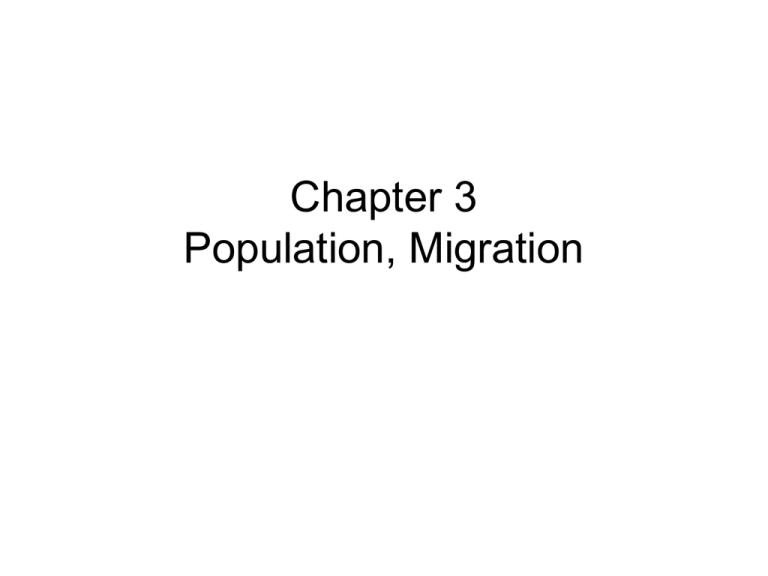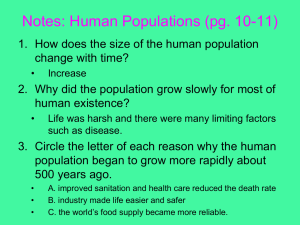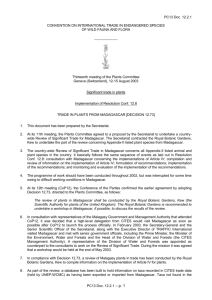Chapter 3 - Geographies of Population
advertisement

Chapter 3 Population, Migration 03.01 Which continent contains the most people? 1. North America 2. South America 3. Europe 4. Asia 5. Africa 03.01 Which continent contains the most people? 1. North America 2. South America 3. Europe 4. Asia 5. Africa Explanation: Asia contains over 60% of the world’s people. 03.02 The demographic center of the United States is currently located in which state? 1. Virginia 2. Kentucky 3. Missouri 4. Texas 5. Colorado 03.02 The demographic center of the United States is currently located in which state? 1. Virginia 2. Kentucky 3. Missouri 4. Texas 5. Colorado Explanation: Half the population of the United States lives north of the demographic center and half lives south of it, while, at the same time, half the population lives east of the point and half lives west of it. 03.03 The count of the number of people in a country, region, or city is a: 1. census 2. vital record 3. crude birth rate 4. middle cohort 5. dependency ratio 03.03 The count of the number of people in a country, region, or city is a: 1. census 2. vital record 3. crude birth rate 4. middle cohort 5. dependency ratio Explanation: Censuses also typically collect information about economic and social characteristics, in addition to numbers of people. 03.04 Which of these countries would have an age-sex pyramid that is most pyramidal in shape? 1. Mali 2. United States 3. Italy 4. all would be equally pyramidal 5. none would have a pyramidal shape 03.04 Which of these countries would have an age-sex pyramid that is most pyramidal in shape? 1. Mali 2. United States 3. Italy 4. all would be equally pyramidal 5. none would have a pyramidal shape Explanation: Mali is a developing country with a high birthrate, and therefore a high percentage of children in the population. 03.05 Information about births, deaths, marriages, and the incidence of certain infectious diseases is known as: 1. census 2. vital records 3. medical geography 4. demography 5. demographic transition 03.05 Information about births, deaths, marriages, divorces, and the incidence of certain infectious diseases is known as: 1. census 2. vital records 3. medical geography 4. demography 5. demographic transition Explanation: Vital records are an important source of information about populations and population dynamics. 03.06 In the Demographic Transition Model, a society in Phase 4 (Industrial) would be characterized by: 1. high birth rates and high death rates 2. low birth rates and low death rates 3. high birth rates but low death rates 4. low birth rates but high death rates 5. a declining death rate and a stable birth rate 03.06 In the Demographic Transition Model, a society in Phase 4 (Industrial) would be characterized by: 1. high birth rates and high death rates 2. low birth rates and low death rates 3. high birth rates but low death rates 4. low birth rates but high death rates 5. a declining death rate and a stable birth rate 03.07 The total number of migrants moving into and out of a place, region, or country is known as: 1. internal migration 2. international migration 3. gross migration 4. eco-migration 5. arithmetic density 03.07 The total number of migrants moving into and out of a place, region, or country is known as: 1. internal migration 2. international migration 3. gross migration 4. eco-migration 5. arithmetic density Explanation: Gross migration is the total number of migrants. If 2000 people moved into a place, and 1000 moved out, the gross migration would be 3000. 03.08 Using this cartogram, how does the population of Australia compare to that of Madagascar? 1. Australia’s population is about ten times that of Madagascar 2. Madagascar’s population is about ten times that of Australia 3. Australia’s population is about three times that of Madagascar 4. Madagascar’s population is about three times that of Australia 5. both populations are about equal in size 03.08 Using this cartogram, how does the population of Australia compare to that of Madagascar? 1. Australia’s population is about ten times that of Madagascar 2. Madagascar’s population is about ten times that of Australia 3. Australia’s population is about three times that of Madagascar 4. Madagascar’s population is about three times that of Australia 5. both populations are about equal in size 03.09 Using this cartogram, how does the population of the United Kingdom compare to that of Ireland? 1. The UK’s population is much larger 2. The UK’s population is slightly larger 3. Ireland’s population is much larger 4. Ireland’s population is slightly larger 5. both populations are about equal in size 03.09 Using this cartogram, how does the population of the United Kingdom compare to that of Ireland? 1. The UK’s population is much larger 2. The UK’s population is slightly larger 3. Ireland’s population is much larger 4. Ireland’s population is slightly larger 5. both populations are about equal in size 03.10 The study of the characteristics of human populations is: 1. cartography 2. regional geography 3. human geography 4. population policy 5. demography 03.10 The study of the characteristics of human populations is: 1. cartography 2. regional geography 3. human geography 4. population policy 5. demography Explanation: Demography, which shares the same root as democracy, is the study of the characteristics of human populations. 03.11 An age-sex pyramid with a tornado-like shape would reflect what kind of community? 1. college town 2. military base 3. traditional suburb 4. retirement community 5. business district 03.11 An age-sex pyramid with a tornado-like shape would reflect what kind of community? 1. college town 2. military base 3. traditional suburb 4. retirement community 5. business district Explanation: A tornado-like shape, or upsidedown pyramid, would reflect a high percentage of elderly residents and few younger residents. 03.12 Population movement caused by the degradation of land and essential natural resources is: 1. eco-migration 2. internal migration 3. demographic transition 4. external migration 5. suburbanization 03.12 Population movement caused by the degradation of land and essential natural resources is: 1. eco-migration 2. internal migration 3. demographic transition 4. external migration 5. suburbanization Explanation: Environmental problems, caused by human or natural disasters, have forced people to migrate to other areas. In recent times, parts of Africa and Asia have experienced high levels of eco-migration. 03.13 Most countries with very high birthrates are located in: 1. North America 2. South America 3. Europe 4. Africa 5. Asia 03.13 Most countries with very high birthrates are located in: 1. North America 2. South America 3. Europe 4. Africa 5. Asia 03.14 The population of individuals born between the years 1946 and 1964 is known as: 1. Generation X 2. Generation Y 3. Baby Boom generation 4. Original Generation 5. Net Generation 03.14 The population of individuals born between the years 1946 and 1964 is known as: 1. Generation X 2. Generation Y 3. Baby Boom generation 4. Original Generation 5. Net Generation Explanation: The Baby Boom is known as such because it reflects a sharp but temporary increase in the birthrate after World War II. 03.15 Which of these countries is expected to decline in population by the year 2020? 1. United States 2. Saudi Arabia 3. Afghanistan 4. Brazil 5. Italy 03.15 Which of these countries is expected to decline in population by the year 2020? 1. United States 2. Saudi Arabia 3. Afghanistan 4. Brazil 5. Italy










